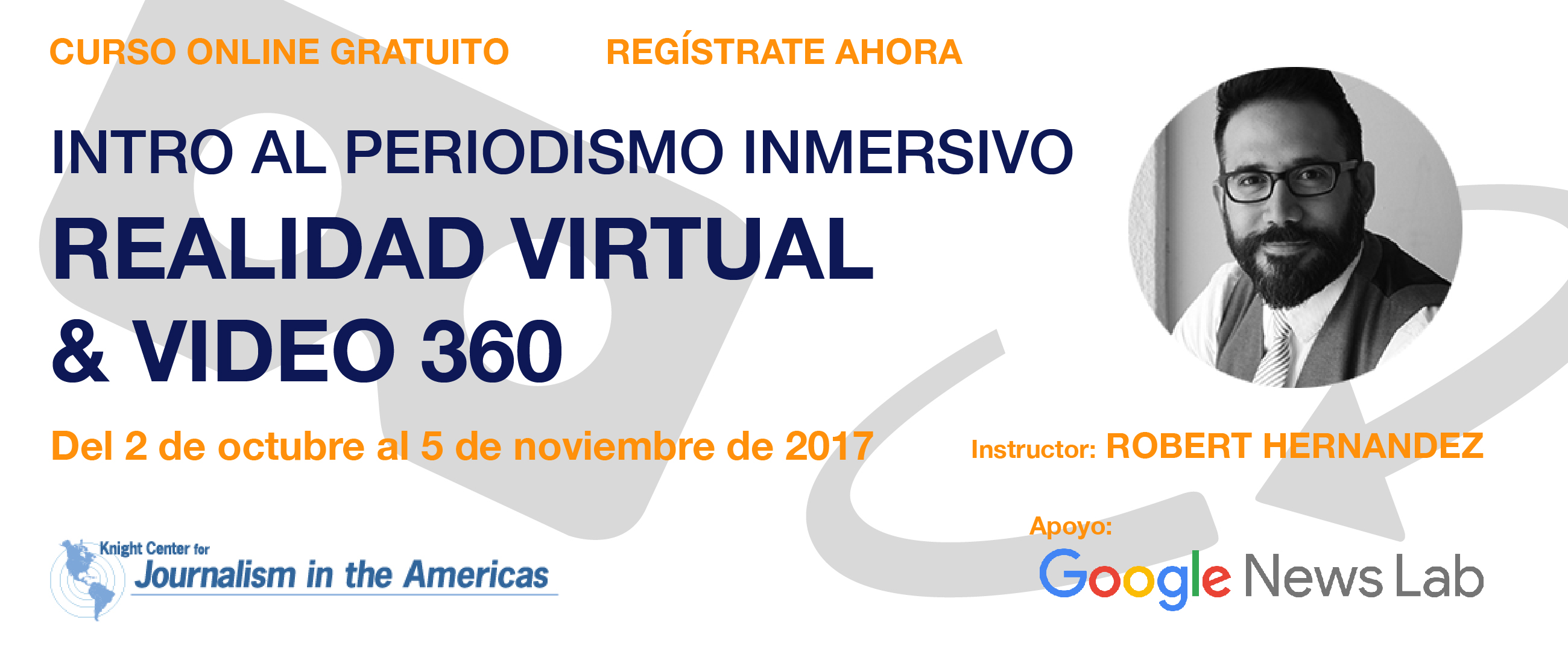
From journeys to Mars to environmental disasters in Brazil, immersive storytelling has been explored in recent years by journalists looking for new ways to bring the world (and universe) to their audiences.
To help more journalists explore these new technologies, the Knight Center is offering the Spanish-language massive open online course (MOOC) “Introduction to Immersive Journalism: Virtual Reality and 360 Video.” This free course is possible thanks to generous support from Google News Lab, which has partnered with the Knight Center to train thousands of journalists in Latin America with free online courses in Portuguese and Spanish.
The five-week course, led by veteran digital journalism instructor Robert Hernández, runs from Oct. 2 to Nov. 5, 2017 and will take students through the basics of immersive storytelling for journalists. Register now to secure a spot.

Hernández will explain how immersive storytelling is being applied to non-fiction narratives and journalism – from content creation to consumption. Students will review how immersive technologies are being used, learn about hardware and software employed in the process and consider ethical questions inherent in the use of this new technology.
“This technology is no longer something from Hollywood sci-fi movies,” Hernández said. “Immersive storytelling is here and it presents a great opportunity for journalists.”
A professor of professional practice at the University of Southern California (USC) Annenberg School, the instructor calls himself a “hackademic” and specializes in offering McGyver-style web journalism solutions. He has worked for seattletimes.com, SFGate.com, eXaminer.com, La Prensa Gráfica, among others. His most recent projects include Augmented Reality, Wearables/Google Glass and Virtual Reality.
Hernández encourages journalists to “be proactive rather than reactive” to what may be the next disruption to the journalism industry.
Though he taught an English course on this topic in March 17 that attracted more than 2,800 students, he said there have been a lot of new developments in the field since and has changed the course to reflect them.
“From new cameras to new software, this course will help the participant get ahead of the next disruption and perhaps become a leader in their field,” Hernández explained.
In this course, students will learn:
The only thing students need to participate in this course is a smartphone with internet access. They will need to install applications that support virtual reality, such as YouTube. The course is designed for journalists, but anyone interested in learning the basics of immersive storytelling can participate. No prior experience with the concepts or tools discussed in the course is required.
The course is divided into five weekly modules consisting of video lessons, lectures, an exam, and a discussion forum.
Like all Knight Center courses, this MOOC is asynchronous, meaning students can complete activities throughout the week at their own pace and at times most convenient for them. However, there are recommended deadlines for completing the weekly modules so as not to fall behind. These can be viewed on the course landing page.
The course is free, but a certificate of completion is available in PDF format for students who successfully meet course requirements that are verified by the Knight Center. The certificate attests to participation in the online course, but no formal course credit of any kind is associated with the document.
This is the third course this year offered by the Knight Center with the support of Google News Lab. The The Knight Center, National Association of Newspapers (ANJ for its acronym in Portuguese) of Brazil and Google News Lab organized the first two MOOCs this year, both in Portuguese. “Fact-checking, the tool to combat fake news” was offered in June and July, and “Video journalism: Visual narratives for digital platforms” ran in July and August.
“We are very grateful for the support we have received from Google News Lab to offer free training to journalists in Latin America. So far, with the MOOCs in Spanish and Portuguese sponsored by Google in the last three years, we have reached 35,000 people from all Latin American countries,” said professor Rosental Calmon Alves, founder and director of the Knight Center.
The Knight Center for Journalism in the Americas was created in 2002 by Professor Rosental Calmon Alves, holder of the Knight Chair in Journalism at the Moody College of Communication School of Journalism at the University of Texas at Austin. The Center has received contributions from the John S. & James L. Knight Foundation and other donors.
The video below is a 360 video. To move it around in different directions, you can drag your mouse across the video display.
The video above was shot in 360 and is not compatible with every browser.
To watch the regular promotional video please click on the following link: https://youtu.be/9UmV2qji6Nk